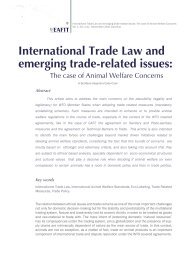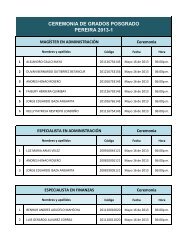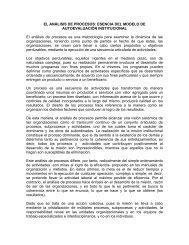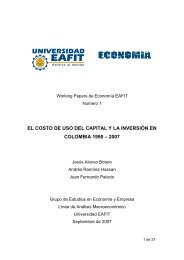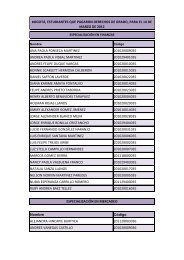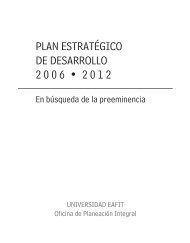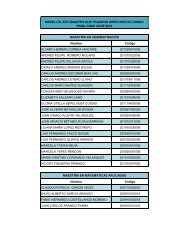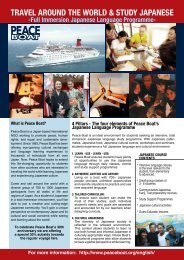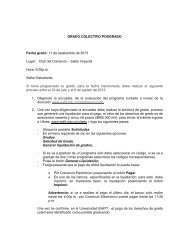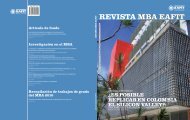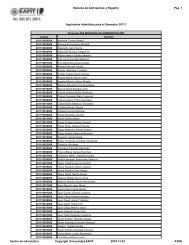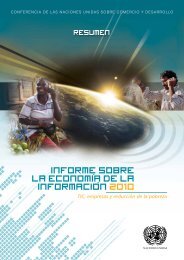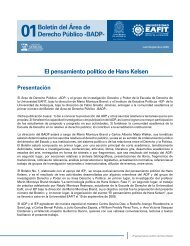The Development of New Zealand and its Relationship with the ...
The Development of New Zealand and its Relationship with the ...
The Development of New Zealand and its Relationship with the ...
- No tags were found...
You also want an ePaper? Increase the reach of your titles
YUMPU automatically turns print PDFs into web optimized ePapers that Google loves.
Young HistoryDutch Explorer Abel Tasman (1642) firstEuropean l<strong>and</strong>ing at Golden Bay, firstEuropean map (Nieuw Zeel<strong>and</strong>).Captain James Cook (1769-1770): Anglicised<strong>New</strong> <strong>Zeal<strong>and</strong></strong>.From 1790: Vis<strong>its</strong> from French, British <strong>and</strong>American whaling, sealing <strong>and</strong> tradingships. Encounters <strong>with</strong> Maori populationmostly peaceful, enthusiastic trading.From 1800: Missionaries settled, conversion <strong>of</strong>Maori to Christianity (well accepted).1815: First European Thomas King was born inNZ.
1840 (6th February) Signing <strong>of</strong> Treaty <strong>of</strong> Waitangi: British Crown <strong>and</strong> fortyMaori chiefs signed treaty, ceding <strong>the</strong>ir sovereignity <strong>and</strong> starting a l<strong>and</strong>dispute that is unresolved until today (different language versions <strong>of</strong><strong>the</strong> treaty).Rationales: Extablishment <strong>of</strong> law <strong>and</strong> order, facilitate orderlysettlement <strong>and</strong> forestall o<strong>the</strong>r European powers colonialisation.1841: Own Colony <strong>of</strong> <strong>the</strong> British Empire, before part <strong>of</strong> <strong>New</strong> South Wales(Australia)
SettlersFrom 1840 European settlements, mainly from Engl<strong>and</strong>, Wales <strong>and</strong>Scotl<strong>and</strong> but also from Irel<strong>and</strong>, lesser extend from <strong>the</strong> US, India,Dalmatia <strong>and</strong> Bohemia.French Settlement in Akaroa (peninsula east <strong>of</strong> Christchurch).L<strong>and</strong> disputes/wars between Maori groups <strong>and</strong> Maori <strong>and</strong> Pakeha(European)1860ies Gold rush era, bringing Chinese settlers in.1870: University <strong>of</strong> <strong>New</strong> <strong>Zeal<strong>and</strong></strong> established (federal university system).Education act: free, secular <strong>and</strong> compulsory schooling for all.1911 Population <strong>of</strong> <strong>New</strong> <strong>Zeal<strong>and</strong></strong> reaches 1 Million (
Technological ChangeEconomic ProsperityUntil 1890 Economy is mainly based on wool <strong>and</strong> local trade.Invention <strong>of</strong> refrigerated shipping (from 1882) – trade <strong>of</strong> meat <strong>and</strong>dairy products becomes possible.Primary sector <strong>and</strong> refrigerated shipping remains <strong>the</strong> main basis <strong>of</strong> <strong>the</strong><strong>New</strong> <strong>Zeal<strong>and</strong></strong> Economy until <strong>the</strong> 1970ies.
Importance <strong>of</strong> Rugby <strong>and</strong> <strong>the</strong> formation(1905) <strong>of</strong> <strong>the</strong> ’All Blacks’ important for<strong>the</strong> country’s development <strong>of</strong> anindependent nation.Growing self-confidence <strong>and</strong> nationbuildingefforts materialised <strong>with</strong> <strong>New</strong><strong>Zeal<strong>and</strong></strong> refusing to join <strong>the</strong> AustralianCommonwealth <strong>and</strong> to change <strong>its</strong>status from colony to ’dominion’ in1907.Participation in WWI <strong>and</strong> WWII in ANZACfor <strong>the</strong> British Empire.ANZACs l<strong>and</strong>ing at Gallipoli, 25th April 191520th Century
20th CenturyGreat Depression hit country hard,sky-rocketing unemployment, butlayed foundations for a socialwellfare state (state-pension, freehealthcare, unemployment benef<strong>its</strong>,free education) <strong>and</strong> ’work camps’ forunemployed created important parts<strong>of</strong> <strong>the</strong> economic infrastructure (i.e.roads, farml<strong>and</strong>, park developments)In 1950 <strong>New</strong> <strong>Zeal<strong>and</strong></strong> was <strong>the</strong> 3rd wealthiest country in <strong>the</strong> world.1960ies: Maori protest movements (challenging <strong>the</strong> conservative NZmainstream culture) – <strong>New</strong> <strong>Zeal<strong>and</strong></strong> remained culturally <strong>and</strong> economically an<strong>of</strong>fshoot <strong>of</strong> Britain (i.e. 1961: 51% <strong>of</strong> exports to UK, almost entirely frozenmeat <strong>and</strong> dairy products).Dramatic change when UK joint Europen Community (1973): EC importrestrictions <strong>and</strong> ’psychological lock-out’ forced NZ to find new exportmarkets, products <strong>and</strong> develop a new national identity, less dependent on<strong>the</strong> UK.
1984 <strong>New</strong> Labour Governmentchanged <strong>New</strong> <strong>Zeal<strong>and</strong></strong>’s foreignpolicy, ended <strong>the</strong> ANZUS treaty <strong>of</strong>cooperation <strong>with</strong> Australia & US dueto differences in nuclear policy –making NZ a ’nuclear free zone’.20th Century1980ies: Liberalisation <strong>of</strong> Immigration, influx <strong>of</strong> Asian immigrants, PacificIsl<strong>and</strong>s (i.e. Cook, Samoa, Fiji) which resulted in a highly multiculturalsociety, i.e. Auckl<strong>and</strong> being <strong>the</strong> largest city for Polinesian <strong>and</strong> South PacificCulture.
<strong>New</strong> <strong>Zeal<strong>and</strong></strong> TodayToday <strong>New</strong> <strong>Zeal<strong>and</strong></strong> remains strong links to <strong>the</strong> UK (o<strong>the</strong>r than Australia<strong>with</strong> <strong>the</strong> US), many Kiwis go for an overseas experience (’OE’) to <strong>the</strong>UK, benefiting from favourable visa requirements.Some constitutional links to <strong>the</strong> British Empire remain: <strong>the</strong> <strong>New</strong> <strong>Zeal<strong>and</strong></strong>Sovereign is a British resident; Head <strong>of</strong> State is <strong>the</strong> Queen <strong>of</strong> Engl<strong>and</strong>,but debates surface from time to time to make <strong>New</strong> <strong>Zeal<strong>and</strong></strong> a republic.
NZ in a NutshellCoat <strong>of</strong> Arms <strong>of</strong> <strong>New</strong> <strong>Zeal<strong>and</strong></strong>Capital: WellingtonGovernment: Parliamentary democracy <strong>and</strong> constitutional monarchyPopulation: 4 268 000 (2008), density 15/sqkmGDP: USD 117.67 bn (2008); PC: USD 27 785 (PPP, 28th rank)
Economic StructurePrimary Sector: SUM: 7.2% <strong>of</strong> GDP <strong>and</strong> over 50% <strong>of</strong> exportsAgriculture (dairy, sheepmeat, cattle);Horticulture (apples, kiwifruit <strong>and</strong> wine),ForestryMining (coal, gas, oil/condensate)FishingEnergy (about 60% from renewable resources:hydropower & wind generation)Secondary Sector:Tertiary Sector:SUM: 14.2% <strong>of</strong> GDPProcessing <strong>of</strong> food <strong>and</strong> wood largest shareSUM: 78.6% <strong>of</strong> GDPFinancial services (reg. assets in banks 294 bn, ’07)Transportation (road, rail, shipping, avaiation)Tourism (major foreign exchange earner: $6.3bn),Tertiary Education (around $ 2 bn)Screen Industry (film, tv)
Economic Structure: AnalysisEconomy is still heavily reliant on primary sector <strong>and</strong> <strong>its</strong> output.Secondary sector is indirectly heavily dependent on primary sector.Biggest corportation <strong>of</strong> <strong>New</strong> <strong>Zeal<strong>and</strong></strong>, Fonterra, is owned by 11,000+farmers <strong>and</strong> controlls over 50% <strong>of</strong> <strong>the</strong> world’s diary trade. Outlook is verygood due to stable domestic ownership structure, world demographicgrowth <strong>and</strong> changes (i.e. Big Emerging Markets), developments <strong>of</strong> bio-fuels<strong>and</strong> related increase <strong>of</strong> commodity prices.
Economic Structure: AnalysisGovernment’s strategic plan is trying to build on NZ’s trading strengths,especially via securing Free-Trade Agreements (’Example: 7th April 2008,China’s signing <strong>of</strong> <strong>its</strong> first comprehensive FTA <strong>with</strong> a developed nation).Fur<strong>the</strong>r, government is striving to generate a ’knowledge society’, in orderto compensate for strong reliance on commodities <strong>and</strong> to hedge againstgeorgaphic location disadvantages for trade <strong>with</strong> tangibles.
Foreign Trade: OverviewPrincipal Merch<strong>and</strong>ise Exports NZD 34.6bn (2007)Dairy produce 18.5%Meat 12.8%Wood 6.2%Machinery 4.5%Aluminium 4.4%Principal Merch<strong>and</strong>ise Imports NZD 40.9bn (2007)Mineral fuels 13.8%Mechanical machinery 13%Vehicles 12.1%Electrical machinery 9.3%Trade Ballance Deficit NZD 6.3bn (2007)
Foreign Trade: OverviewMajor Trading Partners Exports Australia 21.2%(2007) (NZD 34.6bn) U.S. 12.1%Japan 9.8%China, PRC 5.5%UK 5.1%Imports Australia 21.1%(NZD 38.4bn) China 13.3%U.S. 9.9%Japan 9.0%Germany 4.7%UK 2.7%
Foreign Trade: AnalysisVery high dependency on exports <strong>of</strong> commodity type <strong>of</strong> goods,which allow limited value adding <strong>and</strong> differentiation.This is positive, when commodity prices increase (as <strong>the</strong>y docurrently) but creates outside control over important aspects.Government initiatives to create more exports in <strong>the</strong> service sector(tourism, tertiary education, knowledge-based products & services)has been moderately successful, perhaps due to a tradition <strong>of</strong>’reaping easy factor benef<strong>its</strong> from <strong>the</strong> l<strong>and</strong>’, which might beexploitatory <strong>and</strong> not sustainable (i.e. gold, coal, fishing).Most obvious explanation for <strong>the</strong> moderate success rate areinconsistencies between government aspirations (ie. knowledge-basedeconomy) <strong>and</strong> actual policies <strong>and</strong> procedures (i.e. visa policies forforeign graduates; slow investments into vital infrastructure; etc).
Globalisation <strong>and</strong> <strong>the</strong>Challenges for <strong>New</strong> <strong>Zeal<strong>and</strong></strong>Globalisation, what is it?From an IB perspective globalisation can be defined as:’increased interconnectivity <strong>and</strong> interdependencebetween different parts <strong>of</strong> <strong>the</strong> global political,economic, social <strong>and</strong> technological systems’
Globalisation <strong>and</strong> <strong>the</strong>Challenges for <strong>New</strong> <strong>Zeal<strong>and</strong></strong>Globalisation, what is it?Globalisation involves systems on a multitude <strong>of</strong> dimensional levels <strong>of</strong> analysis:<strong>The</strong> extra-institutional environment (i.e. inter-governmental;technological; meta-social);<strong>The</strong> institutional environment (i.e. cultures, legal systems,Business practices);Industries (i.e. <strong>the</strong> ICT industry, car industry, civil aviation);Firms (i.e. Fonterra, Caltex, Solid Fuels, Meridian Energy)Individuals (i.e. managers, entrepreneurs, employees);…<strong>and</strong> <strong>the</strong>ir coevolving interactions over time…
GLOBALISATION <strong>and</strong> <strong>New</strong> <strong>Zeal<strong>and</strong></strong>’s challenges/opportunitiesin <strong>the</strong> international environmentA selection <strong>of</strong> issues/<strong>the</strong>ses which will continue to be influentialfor political & economic futures <strong>of</strong> NZ:1. ’Globalisation diminishes/removes importance <strong>of</strong> geography’2. ’East Asia regaining <strong>its</strong> political & economic dominance’3. ’<strong>Development</strong> <strong>of</strong> Trans-Tasman relationships’4. ’<strong>New</strong> Applications for NZ expertise: Latin America’
NZ’s CHALLENGES in Globalisation1’Globalisation diminishes/removes importance <strong>of</strong> geography’<strong>New</strong> <strong>Zeal<strong>and</strong></strong> is <strong>the</strong> world’s most remote OECD country.Economic Geography <strong>The</strong>ory:’Negative relationship between distance from globalcentres <strong>of</strong> economic activity <strong>and</strong> economic benef<strong>its</strong>’Economic Costs <strong>of</strong> Distance: i.e. access information, technologicalspillovers, transportation, relationship building, etc.
NZ’s CHALLENGES in Globalisation1’Negative relationship betweendistance from global centres <strong>of</strong> economicactivity <strong>and</strong> economic benef<strong>its</strong>’IMF estimate: Productivity gap between NZ<strong>and</strong> o<strong>the</strong>r countries can be partiallyblamed on distance.<strong>The</strong> result <strong>of</strong> productivity problems is a ’ratsrace’, where more resources (i.e. workhours per year) are substituting for lackingincreases in output per hour.
NZ’s CHALLENGES in Globalisation1’Negative relationship betweendistance from global centres <strong>of</strong> economicactivity <strong>and</strong> economic benef<strong>its</strong>’Redding & Venables (2004) estimate thatGDP <strong>of</strong> Australia could be 27% higher ifAustralia was 50% closer to <strong>its</strong> tradingpartners.This estimate can be extended to <strong>New</strong><strong>Zeal<strong>and</strong></strong>.
NZ’s CHALLENGES in Globalisation1BUT:’Negative relationship between distance from globalcentres <strong>of</strong> economic activity <strong>and</strong> economic benef<strong>its</strong>’Did technological advance in transportation, information <strong>and</strong>telecommunication change <strong>the</strong> influence <strong>of</strong> this economicrelationship? ?
NZ’s CHALLENGES in Globalisation1’Negative relationship between distance from globalcentres <strong>of</strong> economic activity <strong>and</strong> economic benef<strong>its</strong>’Leamer (2007) asserts that above hypo<strong>the</strong>sis holds.Ber<strong>the</strong>lon & Freund (2004) calculate that about 25% <strong>of</strong> all world tradestill takes place between countries sharing a common border;50% takes place between trading partners who are less than 3000km apart
NZ’s CHALLENGES in Globalisation1’Negative relationship between distance from globalcentres <strong>of</strong> economic activity <strong>and</strong> economic benef<strong>its</strong>’Some o<strong>the</strong>r implications beside difficult trading environment:<strong>Development</strong> <strong>of</strong> Information & Communication technologies made possibleto now control distant subsidiaries from a distance, which means also thatsome <strong>of</strong> <strong>the</strong> high value economic activities (i.e. corporate leadership) areremoved from remote places like <strong>New</strong> <strong>Zeal<strong>and</strong></strong> (’branch economy problem’).
2GLOBALISATION <strong>and</strong> <strong>New</strong> <strong>Zeal<strong>and</strong></strong>’s challenges/opportunitiesin <strong>the</strong> international environment’East Asia regaining <strong>its</strong> political & economic dominance’Chances for <strong>New</strong> <strong>Zeal<strong>and</strong></strong> based on <strong>the</strong> ’economic distance’hypo<strong>the</strong>sis <strong>and</strong> <strong>the</strong> increasing importance <strong>of</strong> East Asia for <strong>the</strong>global economy?Is <strong>the</strong> world’s centre <strong>of</strong> economic activity coming closer?
2GLOBALISATION <strong>and</strong> <strong>New</strong> <strong>Zeal<strong>and</strong></strong>’s challenges/opportunitiesin <strong>the</strong> international environment’East Asia regaining <strong>its</strong> political & economic dominance’Initiatives:<strong>New</strong> <strong>Zeal<strong>and</strong></strong> signed first Free Trade Agreement <strong>of</strong> any OECDNation <strong>with</strong> China (April 2008). Implications are especiallytrade-emphasised (which is a <strong>New</strong> <strong>Zeal<strong>and</strong></strong> ’habbit’)Foreign Direct Investments (FDI): NZ laggs behind!
Export-focused mentality in a globalising world?Internationalisation: can it halt at <strong>the</strong> export stage?
2Consequences <strong>of</strong> an increasing trade-deficit gap can mean a newdependence on East Asia (as formerly UK)?
3GLOBALISATION <strong>and</strong> <strong>New</strong> <strong>Zeal<strong>and</strong></strong>’s challenges/opportunitiesin <strong>the</strong> international environment’<strong>Development</strong> <strong>of</strong> Trans-Tasman relationships’Most important foreign market, partner, destination <strong>of</strong> FDI, etcis Australia.
GLOBALISATION <strong>and</strong> <strong>New</strong> <strong>Zeal<strong>and</strong></strong>’s challenges/opportunities in <strong>the</strong> international environmentAUSTRALIA: <strong>The</strong> <strong>New</strong> <strong>Zeal<strong>and</strong></strong> Perspective in a Nutshell1. Australia is NZ most important economic relationship,while NZ is less important for Australia.2. Growth in trade, tourism <strong>and</strong> investments is sluggish,especially given <strong>the</strong> CER (closer economic relations)agreement – growth rates in vicinity <strong>of</strong> that to o<strong>the</strong>rpartners.3. Australia has huge market potential for NZ firms, but<strong>the</strong>re are concerns about economic sovereinity4. Persistant imballances in terms <strong>of</strong> trade, investment <strong>and</strong>people – firms <strong>and</strong> people tend to exit to Australia.
4GLOBALISATION <strong>and</strong> <strong>New</strong> <strong>Zeal<strong>and</strong></strong>’s challenges/opportunitiesin <strong>the</strong> international environment<strong>New</strong> Applications for NZ expertise: Latin America?<strong>New</strong> <strong>Zeal<strong>and</strong></strong> has closest economic relationships in South America<strong>with</strong> Chile, overall trade <strong>and</strong> investment relations remain small.In sum, <strong>New</strong> <strong>Zeal<strong>and</strong></strong> considers Argentina, Brazil <strong>and</strong> Chile as botha potential competitor in <strong>the</strong> international agri-business,especially in certain commodities (i.e. dairy) <strong>and</strong> as potentialbusiness partners to sell knowledge-based products <strong>and</strong>technology (i.e. biotechnology, processing, etc.).Some pioneering FDI into Chilean farms where to apply NZagricultural expertise but generally on low level.
Conclusions<strong>New</strong> <strong>Zeal<strong>and</strong></strong> continues to fight <strong>the</strong> economic disadvantages caused by <strong>its</strong>remoteness;Initiatives to move economy to more knowledge <strong>and</strong> intangible (service)value-adding have been moderately successful;Primary sector, especially agriculture (dairy & farming) still most importantsources <strong>of</strong> income <strong>and</strong> prosperity.This appears to be contributing to a positive outlook in <strong>the</strong> light <strong>of</strong> currentlyraising commodity (esp. Food) prices due to growing world population <strong>and</strong>consumption in general.In specific, this might hinder <strong>the</strong> country to develop fur<strong>the</strong>r non-l<strong>and</strong> boundcompetencies, which are hard to grow <strong>and</strong> sustain for <strong>the</strong> future.
ReferencesHistory• Michael King (2003) <strong>The</strong> Penguin History <strong>of</strong> <strong>New</strong> <strong>Zeal<strong>and</strong></strong>.• James Belich, Making Peoples: A History <strong>of</strong> <strong>the</strong> <strong>New</strong> <strong>Zeal<strong>and</strong></strong>ersfrom <strong>the</strong> Polynesian settlement to <strong>the</strong> end <strong>of</strong> <strong>the</strong> nineteenth century(1996) <strong>and</strong> Paradise Reforged: A History <strong>of</strong> <strong>the</strong> <strong>New</strong> <strong>Zeal<strong>and</strong></strong>ersfrom 1880 to <strong>the</strong> Year 2000 (2001).• Ranginui Walker (2004), Ka Whawhai Tonu Matou: Struggle WithoutEnd. General history written from a Māori perspective;• Keith Sinclair, ed., (1996) <strong>The</strong> Oxford Illustrated History <strong>of</strong> <strong>New</strong><strong>Zeal<strong>and</strong></strong>.• Keith Sinclair, A History <strong>of</strong> <strong>New</strong> <strong>Zeal<strong>and</strong></strong>. First published in 1959
REFERENCESArmstrong, Harvey <strong>and</strong> Robert Read. Geographical 'h<strong>and</strong>icaps' <strong>and</strong> small states: Someimplications for <strong>the</strong> Pacific from a global perspective. Asia Pacific Viewpoint 47 (1)2006, pp 79-92.Battersby, Bryn. Does distance matter? <strong>The</strong> effect <strong>of</strong> geographic isolation on productivitylevels. Treasury Working Paper 2006-03. Canberra, Australian Treasury, 2006.Ber<strong>the</strong>lon, Matias <strong>and</strong> Caroline L Freund. On <strong>the</strong> conservation <strong>of</strong> distance in internationaltrade. World Bank Policy Research Working Paper 3293. Washington DC, WorldBank, 2004.Cairncross, Frances. <strong>The</strong> death <strong>of</strong> distance: how <strong>the</strong> communications revolution will changeour lives. London, Orion, 1997.Davis, Graeme <strong>and</strong> Robert Ewing. Why has Australia done better than <strong>New</strong> <strong>Zeal<strong>and</strong></strong>? Goodluck or good management? Treasury Working Paper 2005-01. Canberra, AustralianTreasury, 2005.Disdier, Anne-Celia <strong>and</strong> Keith Head. <strong>The</strong> puzzling persistence <strong>of</strong> <strong>the</strong> distance effect onbilateral trade. Review <strong>of</strong> Economics <strong>and</strong> Statistics Forthcoming.Ewing, Robert <strong>and</strong> Bryn Battersby. Measuring recent trends in Australia's economicremoteness. Treasury Economic Roundup Summer 2004-05 2005, pp 21-31.Friedman, Thomas L. <strong>The</strong> world is flat: a brief history <strong>of</strong> <strong>the</strong> twenty-first century. Revised <strong>and</strong>extended paperback ed. London, Penguin Books, 2006.Fullilove, Michael <strong>and</strong> Chloë Flutter. Diaspora: <strong>the</strong> world wide web <strong>of</strong> Australians. LowyInstitute Paper 04. Sydney, Lowy Institute for International Policy, 2004.Garnaut, Ross. Australia as a branch <strong>of</strong>fice economy. Paper presented at <strong>the</strong> 2002 Conference<strong>of</strong> <strong>the</strong> Australian Agricultural <strong>and</strong> Resource Economics Society (AARES), Canberra,13 February 2002.Gibson, John. Is remoteness a cause <strong>of</strong> slow growth in <strong>the</strong> Pacific? A spatial-econometricanalysis. Pacific Economic Bulletin 22 (1) 2007, pp 83-101.Gil, Indermit <strong>and</strong> Homi Kharas. An East Asian renaissance: ideas for economic growth.Washington DC, World Bank, 2006.Gyngell, Allan, Skilling, David <strong>and</strong> Thirlwell, Mark. Australia <strong>and</strong> <strong>New</strong> <strong>Zeal<strong>and</strong></strong> in a globalising World.Lowy Institute for International Policy Publication, May 2007.Hummels, David. Transportation costs <strong>and</strong> international trade over time. Journal <strong>of</strong> EconomicPerspectives Forthcoming.Kennedy, Peter. A guide to econometrics. Cambridge, MA, MIT Press, 1992.Leamer, Edward E. A flat world, a level playing field, a small world after all, or none <strong>of</strong> <strong>the</strong>above? Journal <strong>of</strong> Economic Literature 45 (1) 2007, pp 83-126.Maddison, Angus. <strong>The</strong> world economy: historical statistics. <strong>Development</strong> Centre Studies.Paris, OECD, 2003.21
REFERENCESOhmae, Kenichi. <strong>The</strong> borderless world: power <strong>and</strong> strategy in <strong>the</strong> interlinked economy.London, HarperCollins, 1994.Redding, Stephen <strong>and</strong> Anthony J Venables. Economic geography <strong>and</strong> international inequality.Journal <strong>of</strong> International Economics 62 2004, pp 53-82.Saunders, Caroline, Andrew Barber <strong>and</strong> Greg Taylor. Food miles - comparativeenergy/emissions performance <strong>of</strong> <strong>New</strong> <strong>Zeal<strong>and</strong></strong>'s agriculture industry. ResearchReport 285. Lincoln, Agribusiness & Economics Research Unit, Lincoln University,2006.Senhadji, Abdelhak. Sources <strong>of</strong> economic growth in <strong>New</strong> <strong>Zeal<strong>and</strong></strong>: a comparative analysis. InSelected Issues - <strong>New</strong> <strong>Zeal<strong>and</strong></strong>. Washington DC, International Monetary Fund, 2004.Skilling, David. Choosing to compete: increasing <strong>the</strong> magnetism <strong>of</strong> <strong>the</strong> <strong>New</strong> <strong>Zeal<strong>and</strong></strong>economy. <strong>New</strong> <strong>Zeal<strong>and</strong></strong> Institute Essay. Auckl<strong>and</strong>, <strong>New</strong> <strong>Zeal<strong>and</strong></strong> Institute, 2006.———. Competing <strong>and</strong> cooperating: growing <strong>New</strong> <strong>Zeal<strong>and</strong></strong>'s economic relationship <strong>with</strong>Australia. <strong>New</strong> <strong>Zeal<strong>and</strong></strong> Institute Essay. Auckl<strong>and</strong>, <strong>New</strong> <strong>Zeal<strong>and</strong></strong> Institute, 2007.———. Lessons from <strong>the</strong> world's economic laboratory: what can Australia learn from <strong>the</strong><strong>New</strong> <strong>Zeal<strong>and</strong></strong> experience? <strong>New</strong> <strong>Zeal<strong>and</strong></strong> Institute Essay. Auckl<strong>and</strong>, <strong>New</strong> <strong>Zeal<strong>and</strong></strong>Institute, 2006.Skilling, David <strong>and</strong> Danielle Boven. Dancing <strong>with</strong> <strong>the</strong> stars? <strong>New</strong> <strong>Zeal<strong>and</strong></strong> InstituteDiscussion Paper 2005/04. Auckl<strong>and</strong>, <strong>New</strong> <strong>Zeal<strong>and</strong></strong> Institute, 2005.———. So far yet so close: connecting <strong>New</strong> <strong>Zeal<strong>and</strong></strong> to <strong>the</strong> global economy. <strong>New</strong> <strong>Zeal<strong>and</strong></strong>Institute Discussion Paper 2007/01. Auckl<strong>and</strong>, <strong>New</strong> <strong>Zeal<strong>and</strong></strong> Institute, 2007.Thirlwell, Mark. <strong>The</strong> new terms <strong>of</strong> trade. Lowy Institute Paper 07. Sydney, Lowy Institute forInternational Policy, 2005.———. Second thoughts on globalisation: can <strong>the</strong> developed world cope <strong>with</strong> <strong>the</strong> rise <strong>of</strong>China <strong>and</strong> India? Lowy Institute Paper 18. Sydney, Lowy Institute for InternationalPolicy, 2007 (Forthcoming).Venables, Anthony J. Shifts in economic geography <strong>and</strong> <strong>the</strong>ir causes. Paper presented at <strong>the</strong>Symposium sponsored by <strong>the</strong> Federal Reserve Bank <strong>of</strong> Kansas. <strong>The</strong> new economicgeography: effects <strong>and</strong> policy implications. Jackson Hole, Wyoming, August 24-262006.World Bank. Reducing trading costs in a new era <strong>of</strong> security. In Global economic prospects2004: realizing <strong>the</strong> development promise <strong>of</strong> <strong>the</strong> Doha Agenda. Washington, DC,World Bank, 2003.



